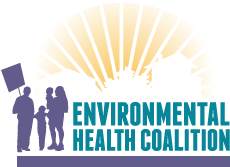IMMEDIATE RELEASE
Community Advocates Celebrate San Diego's Transportation Plan
San Diego Association of Governments (SANDAG) passes the most equitable, environmentally just Regional Transportation Plan to date.
Today, SANDAG’s Board of Directors approved the 2021 Regional Plan (RP), which will determine San Diego County’s transportation future for decades to come. The newly passed RTP provides a pathway to modernize San Diego’s transit system to reduce greenhouse gas emissions, decrease lung-damaging air pollution, and meet the needs of the low-income communities of color who have been hit hardest by the pandemic.
“The planet is burning and our current transportation system is heavily contributing to the fire, damaging our lungs, and failing the low-income communities of color who depend on it the most,” said Carolina Martinez, Climate Justice Director, Environmental Health Coalition. “93% of San Diego’s low-income residents do not have access to fast and frequent transit and the 2021 Regional Plan provides critical lifelines to change that.”
Led by the San Diego Transportation Equity Working Group, residents at the frontlines of the climate crisis in Barrio Logan, City Heights, and National City identified 10 priorities to improve the transit system- the 10 Transit Lifelines. These lifelines reflect a vision to advance affordable and frequent transit solutions that will benefit all San Diegans. Transportation justice advocates have worked for decades to advance expanded transit with little success until the last few years with the SANDAG reforms instituted by AB 805.
“Throughout the planning process, SANDAG was proactive in including our communities, as a result, the 2021 Regional Plan is the most equitable and solution-driven regional plan to date,” said Diane Takvorian, co-founder and Executive Director, Environmental Health Coalition. “The Regional Plan paves a path to make the 10 Transit Lifelines a reality.”
The 10 Transit Lifelines are:
- A Regional Plan that prioritizes environmental justice
- Youth opportunity passes
- Bus service every 10 minutes
- Build a 24-hour Blue Line Express
- 24 – hour service
- Fund the Purple Line
- An all-electric bus fleet by 2030
- Anti-displacement strategies
- Restroom access
- Emergency-ready transit system
“I’ve lost countless moments with my family waiting at bus stops, running to catch the bus, coordinating my life around our inconvenient and unreliable transit system,” said Esperanza Gonzalez, a City Heights Resident who rides the bus to work. “I used my 30 years of experience riding the bus to help develop the 10 Transit Lifelines and it is so encouraging that SANDAG listened to us and passed a regional plan that will improve the lives of working people like me.“
To learn more about Esperanza and the 10 Transit Lifelines, visit enviromentalhealth.org/transitjustice.
###
ABOUT ENVIRONMENTAL HEALTH COALITION
Founded in 1980, Environmental Health Coalition (EHC) builds grassroots campaigns to confront the unjust consequences of toxic pollution, discriminatory land use, and climate change. Visit www.environmentalhealth.org [environmentalhealth.org] to learn more.

